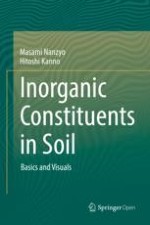Open Access 2018 | Open Access | Book

Inorganic Constituents in Soil
Basics and Visuals
Authors: Prof. Dr. Masami Nanzyo, Prof. Dr. Hitoshi Kanno
Publisher: Springer Singapore
Open Access 2018 | Open Access | Book

Authors: Prof. Dr. Masami Nanzyo, Prof. Dr. Hitoshi Kanno
Publisher: Springer Singapore
This open access book is a must-read for students of and beginners in soil science. In a well-organized and easy-to-follow manner, it provides basic outlines of soil minerals, new methods and recent developments in the field, with a special focus on visual aids.
The chapters on primary minerals, secondary minerals, non-crystalline inorganic constituents and inorganic constituents sensitive to varying redox conditions will help readers understand the basic components of soils. Further, readers are introduced to new analytical methods with the aid of microscopy and recent developments in the field. Uniquely, the book features case studies on the identification and isolation methods for vivianite crystals from paddy field soils, as well as a useful procedure for identifying noncrystalline constituents such as volcanic glasses and plant opals, which can also be applied to other soils depending on the local conditions.
Given its focus and coverage, the book will be useful to all readers who are interested in agronomy, plant production science, agricultural chemistry and environmental science.
In addition, it can help biogeochemists further expand their research work on the rhizosphere of wetland plant roots, iron and phosphate dynamics, etc.